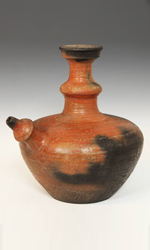Quenching the Soul – Indonesian Kendi Water Vessels
PRIMITIVE - Monday, August 10, 2015By Misaki Imagawa
 |
|
The rich rushing song of a waterfall reached the young man’s ears as he exited a dense jungle and found himself on the banks of a river deep in the heart of Java, Indonesia. The rich foliage reflected its vibrant colors in pools fed by a stream of water falling from a nearby rocky cliff. He picked his way over boulders leading to the waterfall, an earthenware vessel tucked securely under his arm. Cupping one hand under the stream of water, he enjoyed the coolness against his skin, and then lifted the water to his lips. A memory crept in from when he was a little boy, tagging behind his older sister to this very spot below the falls. “Why?” he asked back then, “is the water from this spot so important?” He knew humans and animals needed water to live, but what made this water so special?
 |
|
The inherent importance of water seems to be part of the DNA of all living things. Mankind’s earliest civilizations, starting with Mesopotamia, built villages, towns and cities on the banks of rivers; the flow of water helping to facilitate advancements in agriculture, architecture, transportation and technology. Yet, our ancestors also faced the wrath of nature when it came to water – specifically, too little or too much – which came in the form of severe droughts or merciless floods. In response, many cultures turned to worship various forms of water gods. People thrived under their god’s protection. Certain rivers were declared sacred, and in turn, exceptional vessels were created to store holy water. In Indonesia, these vessels became known as kendi.
Kendi is believed to be derived from the word kundi, which in turn came from the Hindu word kundika, meaning 'water vessel.' Early forms of kundika in India were made from precious metal and associated with gods and rituals. Images of Hindu deities such as Brahma and Shiva are often depicted holding kundika vessels. In Buddhism, kundika are considered one of eighteen holy vessels and can be seen alongside Buddha, Maitreya (the future Buddha) and Avalokitesvara (the enlightened being of compassion). The concept of a holy water vessel seems almost universal.
 |
 |
||
The exact beginnings of the Indonesian kendi are unknown, though some scholars are certain structural influences came from the Indian kundika. Archaeological finds in Indonesia have uncovered water vessels dating as far back as the Neolithic period. The anthropomorphic designs and discovery at burial sites indicate their use and function as a ritual funerary object, most likely a tribute to the ancestors. In addition to serving as funerary objects, kendi were also used for ritual cleansings, as wine servers, vessels to administer medicine, and as everyday water carrying vessels.
 |
|
Every Indonesian kendi is unique in shape and vessels with figurative and zoomorphic motifs hold additional symbolic meanings. In particular, the snake and turtle are revered popular designs. It is believed that the Hindu gods Vishnu and Brahma transformed into a giant turtle and naga serpent in order to create the island of Java. The rooster and hen are seen as symbols of fertility and hope and are often seen at marriage ceremonies. Water buffalo, another auspicious motif, represent strength, wealth, prosperity and prestige. All these animals are symbols that can be found on kendi. However, in general, kendi are bulbous in shape with a thin neck and either one or multiple spouts.
 |
 |
||
Indonesian kendi are typically unglazed earthenware, which allows the water inside to stay cool. Several centuries ago, glazed and porcelain kendi from India and China drew the attention of Europeans. Today, Indonesian kendi are actively pursued by collectors and interior designers for their natural tones and elegant curves that can effortlessly enhance any room or collection. Every kendi is unique; carefully handcrafted while being symbolically designed and decorated. No two are exactly the same. Each has its own character and appearance, which makes them ideal for assembling in collections.
 |
|
The young man filled the kendi under the waterfall. He held it carefully with both hands and studied its curves. His grandmother had made it specifically for a ceremony taking place this day - his sister's wedding day – and it was his job to make sure the vessel was filled with water from this exact spot. He examined the kendi closely. The thin spout and neck were coiled gracefully around each other as if to symbolize the union about to take place. He remembered his sister’s response from years before when he asked her what made water from this waterfall so important. "This is where our god lives,” she told him. “Drink the water to refresh your soul.”
 |
Download this Article: Quenching the Soul.pdf